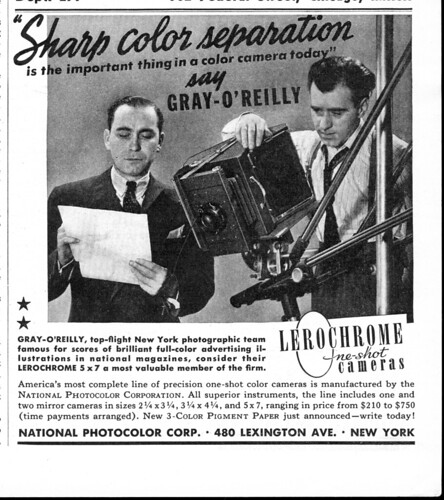Difference between revisions of "Lerochrome"
(+ link to blog post with the camera) |
m (-stub) |
||
| Line 1: | Line 1: | ||
| − | + | ||
<div class="floatright plainlinks" style="margin:0px 0px 15px 15px;"> | <div class="floatright plainlinks" style="margin:0px 0px 15px 15px;"> | ||
{{Flickr_image | {{Flickr_image | ||
Revision as of 08:50, 24 December 2020

|
| Advertisement for Lerochrome 'one-shot' three-color cameras Popular Photography, February 1940. Scan by camerawiki (Image rights) |
Lerochrome is the name of a range of three-color cameras made by the National Photocolor Corporation of New York in the 1930s and '40s. Cameras were made in three sizes: 2¼x3¼ inch, 3¼x4¼ inch (quarter plate), and 5x7 inch, and could use glass plates, cut film or film packs. They are for a 'one-shot' three-color process; that is, three plates, each exposed through a different colored filter, are exposed simultaneously, and the images combined to make one color image. Thus the cameras have three positions for plate-holders, and internal mirrors to split the image-forming light between them.
A 1939 advertisement offers the quarter-plate Lerochrome 'Daylight Special' camera,[1] with an 8¼-inch f/4.5 Meyer Aristostigmat in Compound shutter, and with a coupled rangefinder and parallax-corrected viewfinder. A ground-glass focusing screen can also be used. The dimensions of the camera are 6½x9x9 inches, and its weight 7½ pounds (3 kg). It is metal-bodied, with black crinkle-finish paint and chrome-plated fittings.
Notes
- ↑ Advertisement for Lerochrome cameras by National Photocolor Corp., featuring the quarter-plate 'Daylight Special', in Popular Photography Vol. 5, No. 5 (November 1939), p121; at Google Books.
Links
- National Photocolor Corporation website; the company makes optical pellicle mirrors and filters.
- Lerochrome 5x7 camera featured in a post at the French-language blog, Le blog de la Trichromie